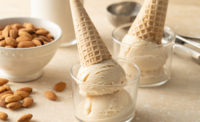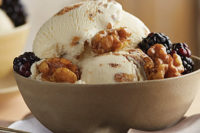Those bragging rights take some digging around on the part of product developers, too, as their search for serendipitous inclusions kicks into high gear.
“Inclusions are in all sorts of items these days, from ice cream and frozen yogurt to cheese, frozen Greek yogurt, ice cream cones and sandwich wafers,” Breedlove said. “The more you can add, the better the experience.”
Breedlove and her creative collaborators hunt for inclusion ideas wherever they lurk.
“We often take group trips to the grocery store to see what’s new,” she said. “We text each other photos of cool dishes we’re eating at restaurants around town. We cut out magazine recipes, watch food shows on TV, learn from our suppliers and break out our own cookbooks for new and exciting things to try or refurbish.”
That explains why the latest dairy inclusions reflect — in miniature — broader trends in food, dining and American culture. For example, shifting demographics have changed the complexion of dairy foods and drinks, along with the inclusions they contain.
“Consumers have more opportunities to try desserts from all over the world, and today’s eaters are not afraid to try new things that go beyond their comfort zones,” Breedlove said. She praises Mexican vanilla for its “very distinct flavor, which lends itself nicely to cake and pie inclusions. And sesame and ginger are other global influences that pair well with more traditional dessert offerings.”
Dairy inclusions haven’t escaped the influence of fine dining, either. Creative restaurant dessert stations are a natural muse for the retail dairy realm. Though drizzled plates and stacked pastry towers may not translate to a tub of ice cream, “the concepts and decadence of rich caramels, truffles and avant-garde flavor combinations can easily be built into dairy inclusions,” Breedlove said.
Good-for-you inclusions
As consumers claim an interest in adopting healthier everyday diets, inclusion designers are shaping their items to follow suit. It may seem counterintuitive, given dairy’s heritage of indulgence. After all, Breedlove asked: “What other industry brags about the amount of butterfat in their products?”
Be that as it may, there’s room in dairy to include good-for-you along with ooey-gooey. The trick, experts say, lies in the balance.
“Our inclusions tend to remain full-flavor because that’s still what consumers want,” said John Nardini, executive vice president of marketing, Denali Flavors, Wayland, Mich. “Consumers may take a lower-fat ice cream, but those brownie pieces better still taste like a great brownie.”
By delivering richness in bite-sized doses, inclusions let consumers enjoy their indulgence bit by bit. Dan Kiniry, director of marketing, Rhino Foods, Burlington, Vt., said single-serve, portion-controlled containers, particularly in ice cream and frozen yogurt, will “strike the best balance between taste, indulgence and managing calorie and fat intake for consumers.”
But the inclusions added to those personally sized products must adapt to the new format, he said. “For instance, size and shape adaptations are needed to fit inclusions into smaller packages and products.”
Nuts, fruits and natural inclusions
Consumers also balance health and indulgence by seeking inclusions that appeal the old-fashioned way: naturally. From sweeteners and colors to flavors and preservatives, consumers say they want the real thing.
Tracy Schrepfer, R&D manager, QualiTech Inc., Chaska, Minn., said “their interest extends to all items, including dairy foods. Accordingly, there has been increasing demand for products containing natural and naturally composed ingredients.”
Some inclusions are natural to begin with.
“Nuts and fruits are popular due to their innate nutrition, and both have been the focus of many positive news stories,” said product developer Kevin W. Holland of Selah, Wash.
Thomas J. Payne, a San Mateo, Calif.-based industry specialist for the U. S. Highbush Blueberry Council, Folsom, Calif., added that “interest in ‘natural’ over ‘artificial’ ingredients has food manufacturers looking for real sources of color.” With few natural blue hues available, “blueberries help formulators bring this appealing color to dairy inclusions,” he said.
Thus they might turn to blueberry juice and purée as ingredients, both of which processors can make from fresh or frozen berries and tailor to meet manufacturer specifications. With a sugar content of 12% and 1.9% acid, they balance the sour taste sometimes associated with items like yogurt, Payne said.
But “natural” means different things to different parties, so establishing the “natural” credentials you’re formulating toward is essential when choosing inclusions.
“Some would argue that any product — even prepackaged whole frozen raspberries — is simply not natural due to the fact that it’s packaged for sale,” said Kim Premo, vice president, research and development, Denali Flavors. “Others define it by the ingredient panel. So, the first thing we do is understand the customer’s definition of what they’re calling ‘natural.’ Once we understand this, then we can formulate a proper product.”
It isn’t always easy. Natural formulation takes some handy ingredients off the table, including partially hydrogenated oils, synthetic colors and modified starches and stabilizers.
“Without a clear definition from the federal government regarding ‘natural,’” Schrepfer said, “we can only focus on the ingredients used without making any specific claims.”
Avoiding the dreaded ice crystal
Natural or not, Holland describes the “ideal” dairy inclusion as “easy to work with; has a long shelf life both in the product and by itself; has little effect on other ingredients in the formulation; and experiences little color, flavor or texture changes over time in the product.”
Formulators with the freedom to explore ingredient options will find that today’s inclusions can pull off all of the above — if their properties suit their destination products. Alas, dairy — high in moisture; often low in pH; subject to agitation, freezing, high-heat processing and more — can by its very nature be a hazardous environment for inclusions.
Consider the effects of moisture. Said Premo, “All inclusions, except high-fat products like chocolate chips or flakes, will absorb moisture in a dairy environment.” Those not based mainly in fat — crisp pretzel bits, fruits, nuts and more — are moisture-vulnerable because “they tend to be drier and want to absorb moisture quicker when put into the product than softer inclusions.”
Those intended for use in refrigerated yogurt face particular risk because the medium has more free water than its frozen cousin.
“This causes many inclusions — unless they 100% fat-based — to draw this moisture in,” Premo said. “The result can be a soggy and unappetizing inclusion in the yogurt. This is why you see hard inclusions packed in a separate well or cap on a yogurt container so consumers can add them right before eating.”
Or you see them enrobed in fat-based coatings. Such coatings, Premo noted, “will slow down the softening process, but will not completely eliminate it.”
Even so, John Pimpo, sales manager, East, Gertrude Hawk Ingredients, Dunmore, Pa., said that moisture management is why “standard porous inclusions like nuts and pretzels are now panned or coated with chocolate to insure their integrity when in frozen desserts.”
And even the interface between the inclusion and the frozen dairy product surrounding it is a garden ripe for ice crystal growth, said Premo. In addition to coatings like the aforementioned chocolate, she points to “robust stabilizer systems” to help stanch water crystallization, allowing the inclusion to maintain its texture and appeal.
Sweeteners to the rescue
But crystallized water isn’t the only menace to inclusion texture in frozen dairy. Indeed, low temperature itself can toughen up many inclusions to the point that they crack teeth.
As Premo said, “Consumers want a great-tasting inclusion that has the texture they would expect from, say, a brownie. That is an obvious challenge in the frozen environment, as we typically don’t eat frozen brownies.”
And yet we still see some of the widest inclusion variety in hard-pack ice cream and frozen yogurt. Why? Because formulators have developed solutions that maintain a pleasant eating texture even in the deep freeze. Some strategies are as simple as a savvy deployment of sweeteners.
“Dried apple dices can become hard in ice cream formulations because of the temperature,” Holland explained. “Sugar-infused apples can stay softer at lower temperatures, and this can be manipulated further by choice of infusion sugar.”
For fat-based inclusions, texture optimization involves manipulating the melt profile by formulating the inclusions with alternative fats.
“In our eyes, the standard chocolate chip had to be modified to be enjoyed in frozen desserts,” Pimpo said. “Standard chocolate tends to be waxy and hard when frozen in ice cream. Consumers are looking for chocolate to ‘eat’ the same in frozen desserts as it would from the local chocolate shop: smooth and indulgent.”
Tropical oils (known for their narrower melt profile) are formulated into chocolate-flavored inclusions, allowing manufacturers to achieve the quicker melt that renders chocolate eatable straight from the freezer. These low-melt inclusions are ideal in soft-serve custards and frozen yogurt, Pimpo added, but not entirely necessary.
“Storage is ultimately the issue here,” Pimpo said. “Since most soft-serve desserts are not stored frozen after being made, shelf-stable inclusions are a fine option.”
Blended dairy drinks like milkshakes, smoothies and those ubiquitous frozen coffee drinks present a whole new set of inclusion requirements.
“The challenge with most customers here is getting an inclusion that is ‘spoonable’ versus ‘sippable,’” Pimpo said. “Some customers in this area are happy to place large inclusions that you can scoop out with a spoon, while others want the inclusions to sip up easily through a straw. It all depends on what the customer is looking for.”
When using inclusions in blended dairy, Schrepfer suggested “maintaining a strict protocol for total blending time, and picking an inclusion starting size designed to be larger than the desired finished appearance.”
What’s ahead
“Years ago you had cookie dough and brownie inclusions, and that was about it,” said Nardini. With advances in processing and flavor technologies, “today we have red velvet inclusions, various mint-based items and flakes of all flavors and sizes.”
Nardini’s colleague and Denali’s executive vice president of sales, Kenny Haller, agrees.
“It’s a different world of inclusions today,” he said. Yet despite all the churn in the category, “there are still key sellers and variations of those items that remain consistent favorites with consumers. We don’t see a day when cookie and brownie pieces go away, that much is for sure,” Haller said. N
Greek yogurt begs for inclusions
As in every other corner of the dairy category, thick and creamy, tantalizingly tart Greek-style yogurt is making its mark on inclusions. Jeff Smith, director, industrial marketing, Blue Diamond Almonds, Sacramento, Calif., said “The Greek yogurt segment is an example where I believe we will see a broader use of inclusions.”
And it’s easy to understand why: the emerging style now brings in more than a third of the revenue in the $6 billion U.S. yogurt category, Smith said. That kind of influence makes for some intriguing formulation possibilities.
“The dynamics in this category, combined with added capacity in the segment, will drive opportunities for more innovation with regard to ingredients,” Smith said. “Manufacturers will need to reach beyond fruits and flavors to find complementary, innovative ingredient inclusions.”
Take savory themes, for example. Smith suggests designing a Mediterranean olive oil and herb profile for a Greek-style yogurt designed for use as a dip with fresh vegetables. Or what about an orange-flavored almond slice delivered in its own little compartment atop the main yogurt container?
“The almonds could be used to carry the flavor into the main product,” Smith said. “A potential benefit to the manufacturer is the ability to maintain production efficiencies with their core yogurt flavor while adding a variety of flavor choices using the almonds as the flavor carrier.”
Smith is bullish on almonds’ ability to drive inclusion innovation.
“As manufacturers look beyond fruits and flavors for innovative ideas, almonds meet many of the requirements consumers desire for healthy inclusions,” he said. “As consumers continue to demand better-for-you ingredients, almonds will continue to be a top choice as a favored nut and one that provides a satisfying taste, crunch, texture and nutritious profile.”




